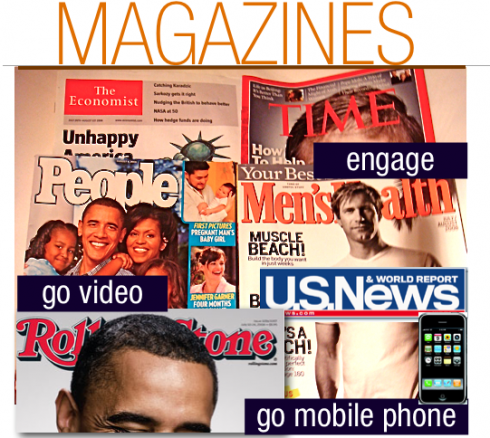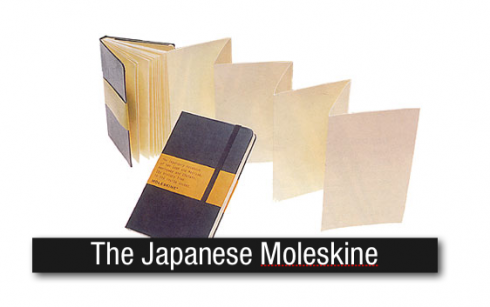
I sit having lunch with longtime friend and colleague, Kerry J. Northrup, director of IFRA Publications. Suddenly he pulls out his new Japanese Moleskin, which opens like an accordion, or a fan. It is a small book; I glance quickly and see sketches, notes, capital letters, and arrows.
My curiosity overwhelms me.
“Wow, Kerry, that must have been some inspiring day you had, all those notes and sketches,” I asked, my eyes jumping all over his book as he fanned the pages.
“It was a conference I attended in New York, about magazines. Fascinating stuff. Let me tell you all about it,” he said.
So he did and I found it interesting enough to share with you here. A lot of this applies to dissemination of news generally, and especially to newspapers.
The highlights, in Kerry’s words:
—Video big time (I mentioned this one) for interviews, demonstrations,
Ads, site visits, equipment
—Professional social networking, a la LinkedIn (FaceBook/MySpace for
Grownups seeking business rather than buddies)
—What we want is engagement, not community.
—Magazines are not the main business for lots of companies that publish
them, especially B2B magazines. Why do they do it? Their magazines give them “style.” IFRA Magazine gives IFRA “style.” (I like that thought)
—We’re not in the magazine business; we’re in the branded content business
—Avoid GMOOT (get me one of those) – meaning what the CEO tells you every time he sees some new thing he thinks we should be doing too.
—U.S. recession predicted to cause a 2% decline in magazine revenues;
growth during this period will be almost entirely on digital
—the “two-headed sales call” : approaching advertisers with separate but
integrated print and digital sales options, not just one big conglomeration,
since they still think of the two as separate media
—360 vs. Platform Centric ad sales organization – 360 can be a terrible
time sink, despite all the hype about thoroughly integrated print-digital. A
hybrid approach is account based.
—From a presentation on “Metrics in the Age of Engagement”—research
proves, if you are actively interested in buying a car, you’ll read all six
pages about the new car. If you are only passingly interested because you
aren’t in the market for a car, we need alternatives to draw you in, such as
a virtual test drive.
—mobile phones can do the web more today (a la iPhone). Businesses think that is great because their web site is now part of their mobile strategy. But that’s tech-centric thinking. User-centric asks what they want to do on their mobile when they are away from their desk/computer vs. when they are sitting in front it. That argues for a different mobile web site.
? 10-15% increase in mobile web use in past several months due to iPhone and Apple advertising, regardless of whether people are using iPhone or something else.

THREE THAT APPLY DIRECTLY TO NEWSPAPER PUBLISHERS AND EDITORS:
1. Video big time—-your multimedia package is essential.
2. Mobile phones can do the web more today (a la iPhone). Businesses think that is great because their web site is now part of their mobile strategy—-think the path of the story starting with alerts for breaking news
3. What we want is engagement, not community—-and engagement begins right on page one, with a story that seduces, not the one that we already knew about
<![]()

The conference: The min day Summit, New York City, April 15, 2008
See http://www.minonline.com/mds
Kerry J. Northrup
IFRA . Publications
northrup@ifra.com
All about the Japanese Moleskin:
http://www.moleskineus.com/japanesebook.html
![]()
Christian Fortanet and I continue to work in Lagos, Nigeria, with a fantastically talented team of editors and designers as we shape what will be the next English-language daily here. Today we discuss the Sunday and online editions. When Christian and I are not reviewing pages, sketching new ones, or in conference with the creative team, we escape to take a look at the immense and overwhelming scene that is Lagos:
*The sides of the roads represent an endless “mall”: with highlights such as
—The young woman merchant, carrying what seems like a thousand guavas on her head without losing her balance, or her temper (try that Naomi Campbell).
—The single-seat portable barbershop, al fresco: the barber can operate in one street in the morning, and move his shop across town to tender to a different clientele in the afternoon. No electrical outlets needed. Plain, old scissors. I rolled down my car window and could hear the click click, while the cars pass dangerously close by. The idea of a close shave here takes a different meaning—-as with a red Honda.
-The fruit juice stand: big colorful tanks with a variety of flavors—-I wondered what the deep purple juice was. The friendly attendant calls it Passionata—a mix of passion fruit, maracuja, mango, papaya, oranges, mandarins and guavas. Anything with Passion in the name, I must try, but Christian refused.
—the soup vendor: she announces “barracuda soup today, lentil okra also available”. Lentil/okra? I am intrigued, Christian isn’t.
-the iron gates shop: every possible iron gate resting on bricks by the side of the road. Two or three possible customers standing by. Pick your favorite gate, load it on the truck, and take it home. One in particular, the one with gold and black ornaments looks like it once opened into the driveway of a palatial British-style home.
And, if you are wondering why I have no photos of these scenes: the traffic moves fast, my iPhone can’t work that fast, and just when you are about to aim at one scene, the next one is more exciting.
Did I mention the coconut stand where you can grab a coconut, have it open in front of you with a machete, and then put a straw to sip that delicious coconut water? I tell Christian that we should stop here. I grew up drinking coconut water out of coconuts in my native Cuba, so I am game. Christian, born in Spain, looks at me as if I am crazy.
Maybe tomorrow.